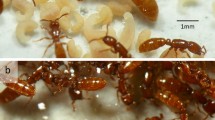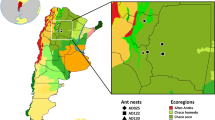Summary
Queen/worker dimorphism is distinct inRopalidia montana. The body size differs significantly between the castes in seven parts measured: Head width, width of mesonotum, alitrunk length, widths and lengths of first and second gastral tergites. There is no size overlap between queens and workers with respect to the width of first gastral tergite and the length of second gastral tergite. Queen/worker ratio of alitrunk length is 1.14. Allometric growth in this species seems to be monophasic.
Resume
Le dimorphisme reine/ouvrière est distinct chezRopalidia montana. La taille du corps est significativement différente entre les castes pour les 7 mesures suivantes: largeur de la tête, largeur du mésonotum, longueur du mésosome, longueur et largeur des premier et deuxième tergites du gastre. Il n'y a pas de recoupement de taille entre les reines et les ouvrières pour les mesures suivantes: largeur du premier tergite du gastre et longueur du deuxième tergite du gastre. La ratio reine/ouvrière pour la longueur du mésosome est égale à 1,14. La croissance allométrique chez cette espèce semble être monosphasique.
Similar content being viewed by others
References
Blackith R.E., 1958. — An analysis of polymorphism in social wasps.Ins. Soc., 5, 263–272.
Carl J., 1934. —Ropalidia montana u. sp. et son nid. Un type nouveau d'architecture vespienne.Rev. Suisse Zool., 41, 675–691.
Gadagkar R., 1980. — Dominance hierarchy and division of labor in the social wasp,Ropalidia marginata (Lep.) (Hymenoptera: Vespidæ).Curr. Sci., 49, 772–775.
Gadgil M., Mahabal A., 1974. — Caste differentiation in the paper waspRopalidia marginata (Lep.).Curr. Sci., 43, 482.
Jeanne R.L., 1980. — Evolution of social behavior in the Vespidæ.Ann. Rev. Entomol., 25, 371–396.
Jeanne R.L., Fagen R., 1974. — Polymorphism inStelopolybia areata (Hymenoptera, Vespidæ).Psyche, 18, 155–166.
Pardi L., 1974. — Polymorphismus bei sozialen Faltenwespen, pp. 216–245, in Schmidt G.H. (ed.), Sozialenpolymorphismus bei Insekten.Wissenschaftliche Verlagsgesellschaft MBH, Stuttgart.
Pardi L., Marino-Piccioli M.T., 1981. — Studies on the biology ofBelonogaster (Hymenoptera, Vespidæ). 4. On caste differences inBelonogaster griseus (Fab.) and the position of this genus among social wasps.Monit. Zool. Ital., N.S., Suppl. XIV, 9, 131–146.
Richards O.W., 1969. — The biology of some W. African social wasps (Hymenoptera: Vespidæ, Polistinæ).Mem. Soc. Ent. Ital., 48, 79–93.
Wilson E.O., 1971. — The insect societies.The Belknap Press, Harvard Univ. Press, Cambridge, Mass., 548 pp.
Author information
Authors and Affiliations
Additional information
Research Trips for Agricultural and Forest Insects in the Subcontinent of India (Hokkaido University, University of Calcutta, and Zoological Survey of India Joint Project). Scientific report No. 12.
Rights and permissions
About this article
Cite this article
Yamane, S., Kojima, J. & Yamane, S. Queen/worker size dimorphism in an oriental polistine wasp,Ropalidia montana Carl (Hymenoptera: Vespidae). Ins. Soc 30, 416–422 (1983). https://doi.org/10.1007/BF02223973
Received:
Accepted:
Issue Date:
DOI: https://doi.org/10.1007/BF02223973




